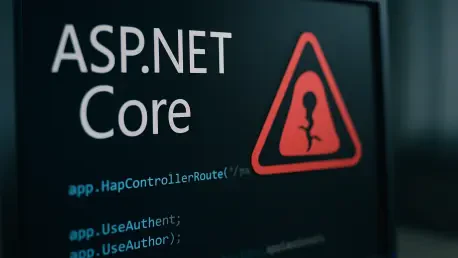Diving into the world of cybersecurity, we’re thrilled to sit down with Rupert Marais, our in-house security specialist renowned for his deep expertise in endpoint and device security, cybersecurity strategies, and network management. Today, Rupert sheds light on a critical vulnerability in Microsoft’s ASP.NET Core framework, specifically within the Kestrel web server component, which has garnered a staggering CVSS score of 9.9. Our conversation explores the nature of this flaw, its potential risks, the controversy surrounding its severity rating, and actionable steps developers can take to safeguard their applications. Join us as we unpack the intricacies of request smuggling, security bypasses, and the challenges of identifying vulnerable code in this high-stakes digital landscape.
Can you walk us through what this ASP.NET Core vulnerability with a CVSS score of 9.9 actually entails?
Sure, this vulnerability is a serious issue in the Kestrel web server component, which is the built-in server for ASP.NET Core. It allows for a type of attack called request smuggling, where an attacker can hide an extra request inside a legitimate one. This can trick the server into processing something it shouldn’t, often bypassing critical security measures. It’s a big deal because it affects all supported versions of ASP.NET Core, from older ones like 2.3 to the latest pre-release of version 10. The high CVSS score of 9.9 reflects just how dangerous this could be in the worst-case scenario.
How does request smuggling play a role in exploiting this flaw?
Request smuggling happens when an attacker crafts a request in such a way that the server misinterprets the boundaries between multiple requests. In this case, they can sneak in a hidden request within another one. For example, the initial request might not need authentication, but the smuggled one could be something that normally would—like logging in as another user. The server processes it without realizing it’s malicious, which can lead to unauthorized access or other harmful actions.
Why is this vulnerability rated so highly at 9.9 on the CVSS scale?
The 9.9 score comes from Microsoft’s approach of rating vulnerabilities based on the absolute worst-case scenario. Here, the flaw is seen as a security feature bypass that changes scope, meaning it can fundamentally undermine core protections like authentication. While in typical use cases the impact might not be as severe, if an application is coded in a way that skips essential checks, the consequences could be catastrophic. That’s why they’ve assigned such a high score—to emphasize the potential for disaster if the right conditions are met.
What kinds of risks should developers be most concerned about with this vulnerability?
The risks are pretty varied and depend heavily on how an application is built. A smuggled request could bypass authentication, letting an attacker act as a legitimate user. It could also evade cross-site request forgery protections or enable injection attacks, where malicious code or data gets inserted into the system. The worst part is that the impact isn’t always obvious—it hinges on specific app behaviors, so some systems might be sitting ducks without the developers even realizing it.
Under what circumstances is an application most likely to be at risk from this issue?
Applications are most at risk when they don’t rigorously validate every incoming request or when they have custom logic that might skip standard security checks. For instance, if an app relies on authentication rules but doesn’t double-check them consistently, a smuggled request could exploit that gap. Also, apps directly exposed to the internet without a protective gateway or reverse proxy are more vulnerable since there’s nothing to filter out these malicious requests before they hit the server.
There’s been some debate about the 9.9 CVSS rating. Can you explain why Microsoft scored it so high despite some pushback?
Microsoft’s reasoning for the 9.9 score is tied to their policy of evaluating vulnerabilities based on the most severe possible outcome. They’re looking at a situation where this flaw could completely bypass a security feature and affect a broader scope of the system. Even if most real-world scenarios wouldn’t hit that level of severity, they want to signal the potential danger. It’s a bit of a wake-up call to developers to take this seriously, even if their specific setup might not be at immediate risk.
How can developers figure out if their application might be vulnerable to this flaw?
Identifying vulnerability isn’t straightforward because it’s not about a specific line of code—it’s about how the app handles requests overall. Developers need to review if their application does anything unusual with request processing or if it might skip validation steps under certain conditions. Unfortunately, there’s no clear-cut checklist; it’s more about understanding your app’s behavior. Tools like security scanners might help flag odd request patterns, but a deep code review is often the best bet to spot potential issues.
What practical steps can developers take to protect their applications from this vulnerability?
The first and most urgent step is to patch the system. Developers should update to the latest version of the .NET SDK or grab the updated Kestrel.Core package through NuGet—version 2.3.6 for older setups. If the app uses a framework-dependent deployment, they’ll need to update the server environment itself since the app relies on the server’s .NET runtime. Beyond that, using a reverse proxy or gateway that can strip out smuggled requests adds an extra layer of defense. Patching ASAP is key, but assessing your app’s specific risks is just as important.
Can you explain the role of Kestrel in ASP.NET Core and why this vulnerability in it is so concerning?
Kestrel is the default web server built into ASP.NET Core, handling incoming HTTP requests for most applications built on this framework. It’s widely used, sometimes directly exposed to the internet, other times behind a reverse proxy. The concern with this vulnerability is that Kestrel is so central to how these apps function—any flaw in it can potentially impact a huge number of systems. Since it’s often the first point of contact for requests, a bug like request smuggling can open the door to bypassing security at a very fundamental level.
What’s your forecast for the future of vulnerabilities like this in web server technologies?
I think we’re going to see more of these kinds of vulnerabilities as web server technologies become increasingly complex and interconnected. With frameworks like ASP.NET Core being used in diverse environments, the attack surface just keeps growing. My forecast is that we’ll need even tighter integration of security practices into the development lifecycle—think automated testing for edge cases like request smuggling from day one. Developers and companies will also need to prioritize rapid patching and better education around secure coding to stay ahead of these threats.









